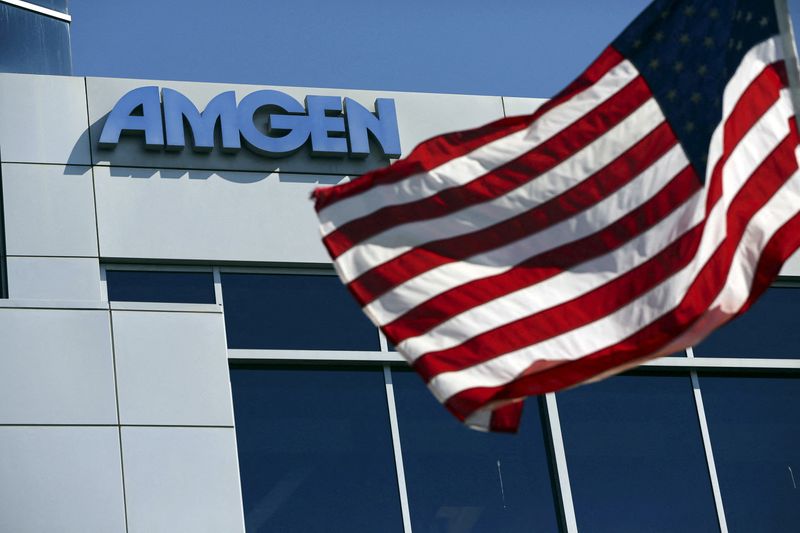By Deena Beasley
(Reuters) - Upcoming data from a mid-stage study of Amgen (NASDAQ:AMGN)'s experimental weight-loss drug MariTide will shed light on how well it might measure up against the popular GLP-1 drugs sold by Eli Lilly (NYSE:LLY) and Novo Nordisk (NYSE:NVO).
Encouraging comments from Amgen about the 52-week Phase 2 trial helped fuel an 8% rise in the company's shares over the past year. That rally lost steam in recent weeks as investors sought details on the injected drug's safety profile.
"We are thinking of the stock as being a double-edged sword highly dependent on late 2024 MariTide's data," Mizuhu analyst Salim Syed said in a recent note.
Amgen has said its drug could offer quicker weight loss and possibly better weight maintenance, as well as fewer shots, than once-weekly GLP-1s such as Novo's Wegovy and Lilly's Zepbound.
"MariTide has the potential to be the first therapy in this setting with monthly or even less frequent dosing," Chief Scientific Officer Jay Bradner said on a recent conference call.
Wall Street analysts expect the multi-dose trial to show weight loss of at least 20% and have highlighted the need for details on potential side effects including nausea, bone density issues, heart rate and blood sugar.
Wegovy was approved for obesity in 2021 after studies showed that it led to 15% weight loss over 68 weeks, while Zepbound demonstrated weight loss of more than 22% over 72 weeks.
"Achieving over a 20% weight loss from baseline is a minimum bar for MariTide, but many investors will be looking for closer to 25%," said William Blair & Co analyst Matt Phipps. The trial needs to demonstrate that weight loss is linked to the dose amount, he said.
Amgen plans to announce the Phase 2 trial results before year-end and has already outlined plans for Phase 3 testing needed to submit the drug for regulatory approval.
MariTide could eventually enter an obesity drug market forecast by some analysts to reach over $150 billion a year.
A small Phase 1 trial showed that the highest dose tested, given monthly for three months, led to 16% weight loss versus a placebo that was maintained for 70 days.
The drug, however, was associated with nausea and vomiting "that led half of patients to quit the trial," said Morningstar analyst Karen Anderson.
"Phase 2 gives Amgen a chance to perfect the dose size and how quickly patients ramp up their dosing, to maximize weight loss and reduce side effects," she said. "I’m expecting significantly higher weight loss, likely well above the 18% levels we saw for Lilly’s Zepbound at 48 weeks."
If Amgen does not provide information on nausea rates and severity, "it will be viewed negatively," Phipps said.
Wegovy causes nausea in more than 40% of patients, while Zepbound has a rate of about 25%.
DIFFERENT APPROACH
Wegovy targets receptors for the appetite- and blood sugar-reducing hormone GLP-1. Zepbound stimulates both GLP-1 and a second gut hormone called GIP.
Amgen's approach is different. MariTide is an antibody linked to a pair of peptides that activates the GLP-1 receptor while blocking the GIP receptor.
Amgen shares closed at $287.87 on Wednesday, down about 9% from earlier this month, when analysts at Cantor Fitzgerald said their review of Phase 1 MariTide data showed a drop in bone mineral density, which can increase the risk of fractures.
Some research has suggested that GIP helps build bones, so Amgen's strategy of tamping down the hormone, as the Cantor report noted, raises a theoretical concern about bone loss.
Amgen issued a statement saying it "does not see an association between the administration of MariTide and bone mineral density changes."
The company previously explained that MariTide was developed out of genetic data showing that GIP inhibition is protective against obesity.

If the Phase 2 trial shows weight loss of 23% to 25% or more, with a patient dropout rate below 10%, and includes quarterly dosing, shares of Amgen could jump 20%, according to Jefferies analyst Michael Yee.
If the weight loss is below 20% and the dropout rate is over 15% due to safety concerns or high rates of nausea and vomiting, the stock could fall as much as 20%, he said in late October.